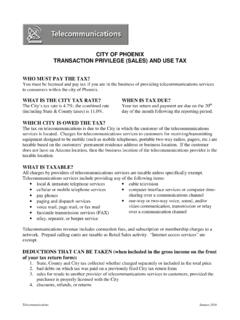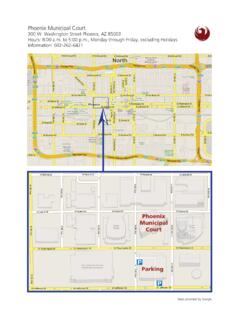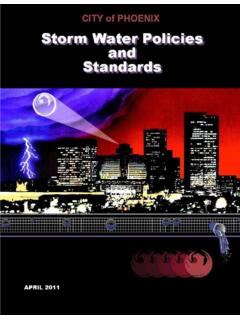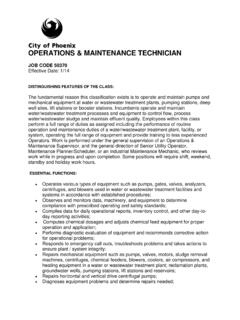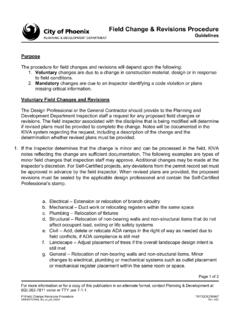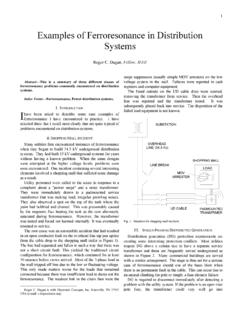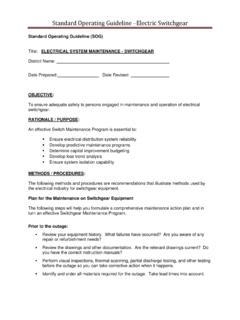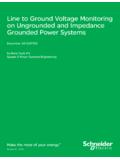Transcription of NATURAL GAS EMERGENCIES M.P. 204.05 10/97-R …
1 PHOENIX REGIONAL STANDARD OPERATING PROCEDURES NATURAL GAS EMERGENCIES 10/97-R Page 1 of 3 Fire Department units may encounter NATURAL gas in a variety of situations and incident types, each presenting a different set of hazards and problems. The following guidelines present an approach which will be applicable in the majority of situations, but do not replace good judgment and experience in dealing with any particular incident. The guidelines should be used whenever situations are encountered that do not clearly indicate that a different approach is required to more safely resolve the hazard. NATURAL gas is much lighter than air and will usually dissipate rapidly in the outside environment. Inside buildings, however, it tends to pocket, particularly in attics and dead air spaces. The flammable limits are approximately 4% to 15% in air. NATURAL gas itself is nontoxic, however, it displaces oxygen and can result in asphyxiation if in a confined space.
2 Flammable gas ranges can only be determined by a combustible gas instrument. Request the dispatch of a Hazardous Incident Response Team (HIRT) unit and utility company. Burning NATURAL gas should not normally be extinguished, since this would change the situation from a visible to invisible hazard with explosive potential. Fires should be controlled by stopping the flow. A. INCIDENTS AT WHICH AN EXPLOSION HAS OCCURRED Units arriving at the scene of a structural explosion must consider NATURAL gas as a possible cause. Explosions have occurred in structures which were not served by NATURAL gas. Underground leaks may permit gas to travel considerable distances before entering a structure through the foundation, around pipes or through void spaces. In these circumstances, the cause of the explosion may be difficult to determine. 1. Until it can be determined that the area is safe from the danger of further explosions, evacuate all civilians and keep the number of Fire Department and/or other emergency personnel ( , gas company personnel) in the area, to the minimum number necessary to stabilize the situation.
3 Take a pessimistic point of view. 2. Do not rely on gas odor. Use combustible gas indicators to check all suspected areas. Both gas company personnel and the Hazardous Incident Response Team ( ) have combustible gas indicators for this purpose. 3. Check areas systematically using combustible gas indicators. Start outside of the area of the explosion, and move into the area until readings indicate detectable concentration. Map the readings for the affected area. 4. If a gas concentration is encountered inside, adjacent to, or underneath any building, secure all possible sources of ignition in the affected area. Cut electricity from outside the affected area to avoid arcing. Ventilate buildings where gas is found with explosion proof equipment only. PHOENIX REGIONAL STANDARD OPERATING PROCEDURES NATURAL GAS EMERGENCIES 10/97-R Page 2 of 3 5. The use of ground probes is essential to evaluate potential underground leaks.
4 When gas company personnel are on the scene, ground probe readings and locations must be coordinated. Time, location, and concentration should be recorded for each probe--sub-sequent readings should be taken from same holes when possible. 6. Command shall provide for effective interaction between gas company personnel and the Fire Department. Gas company personnel are responsible for locating and eliminating leaks in the gas system. As industry specialists, they can provide Command with valuable assistance in the effective handling of these incidents. In most cases, a company officer with a portable radio will be required to supervise during on-site operations. 7. Command must ensure the safety and stability of the structure. If further collapse is possible, the Trench Rescue Team/Heavy Rescue Team should be called to provide shoring, cribbing or other means of stabilizing the structure.
5 B. INCIDENTS INVOLVING A REPORTED GAS LEAK - NO FIRE OR EXPLOSION Calls for "odor of gas," "gas leak," "broken gas line" and similar situations may range from minor to potentially major incidents. All of these should be approached as potentially dangerous situations. With gas company personnel on the scene of an incident, it shall be standard procedure for the first Fire Department unit to provide effective interaction between agencies. Gas company personnel shall be responsible for locating and eliminating leak sources. Gas company personnel and/or the shall obtain a sufficient number of gas concentration readings, using their combustible gas indicators for Command to evaluate the hazard and take appropriate action. In all cases, Fire Department units shall take whatever actions are necessary to provide for life and property safety. The Hazardous Materials Plan should be used as a basic guide for these incidents.
6 A minimum number of personnel should be allowed to enter the area to size-up the situation while any additional units stage in a location out of the potentially dangerous zone. 1. Evacuate any civilians in the area of escaping gas. 2. Attempt to locate the source of the gas and any shutoff devices available. 3. Gas leak situations within a building where the source of the leak is unknown or uncontrolled, the gas supply shall be shut off at the meter. Command shall ensure the meter is red-tagged and locked off until repairs are completed. This is most easily accomplished with the cooperation of the gas supplier at the scene. PHOENIX REGIONAL STANDARD OPERATING PROCEDURES NATURAL GAS EMERGENCIES 10/97-R Page 3 of 3 4. If there is any indication of gas accumulating within a building, evacuate civilians from the structure and control ignition sources. Check for explosive concentrations with a combustible gas indicator if there is any suspicion of accumulation within a structure.
7 Shut off electrical power from an outside breaker. Ventilate using explosion proof blowers to pressurize if necessary. 5. If gas company personnel must excavate to shut off a leak, provide stand-by protection with a charged 1-1/2-inch line and two firefighters in full protective equipment and SCBA. C. PERSONNEL SAFETY All personnel working in the vicinity of a known or suspected gas leak shall wear full protective clothing with SCBA's. Personnel working in a suspected ignitable atmosphere ( , attempting to shut off a gas line) shall be breathing air from SCBA and shall be covered by a manned protective hoseline. The number of exposed personnel will be kept to an absolute minimum at all times. A Limited Access Zone shall be established and maintained around any suspected gas leak and "fire line" tape should be used to identify the Limited Access Zone when necessary. A lobby sector shall be established for personnel control and accountability and where necessary, a hazard sector should be established.
8
